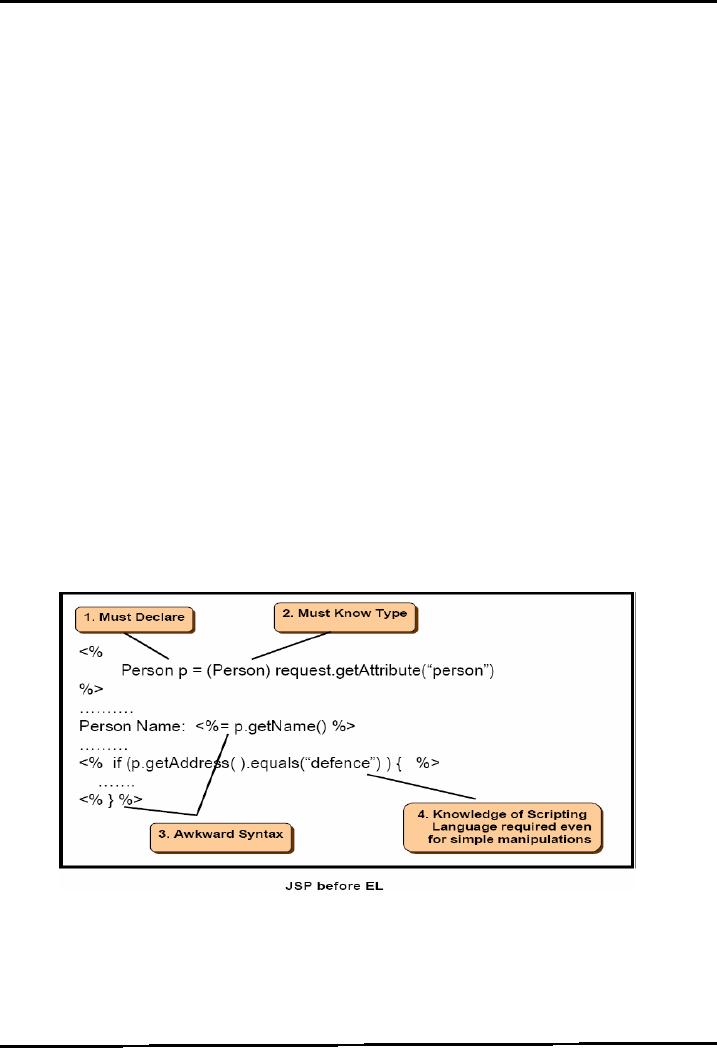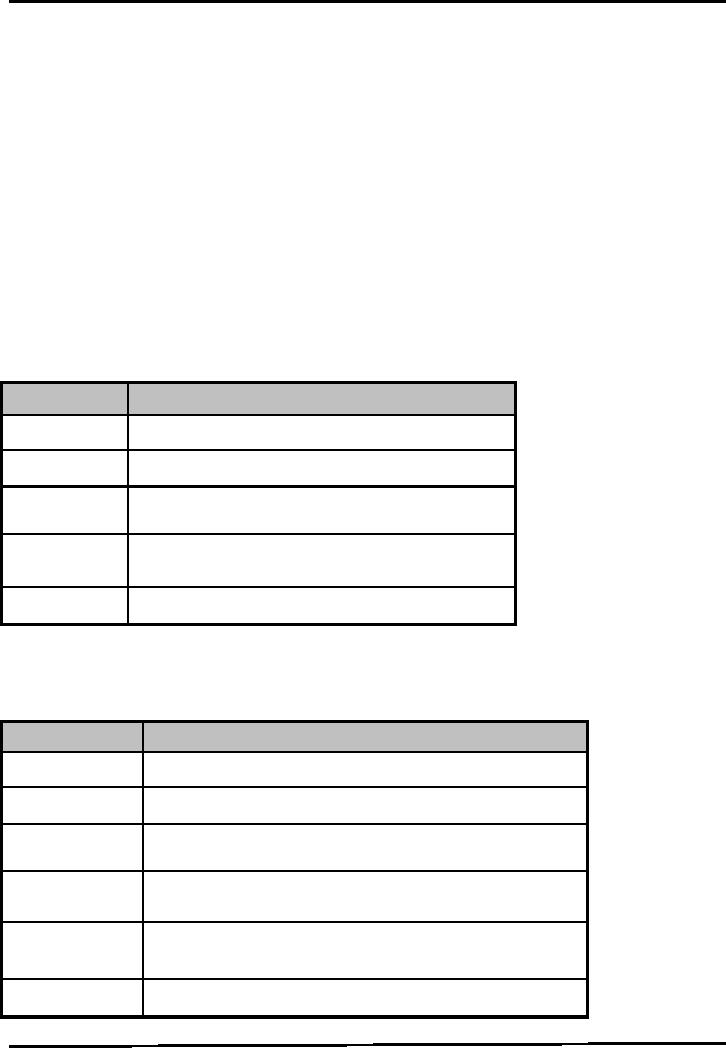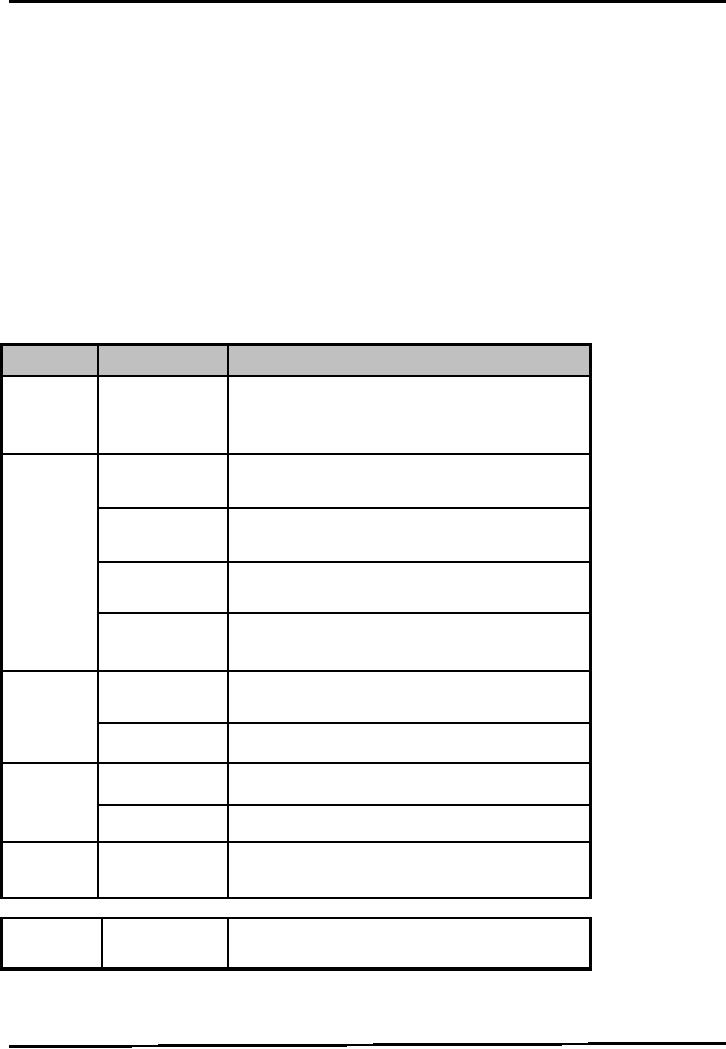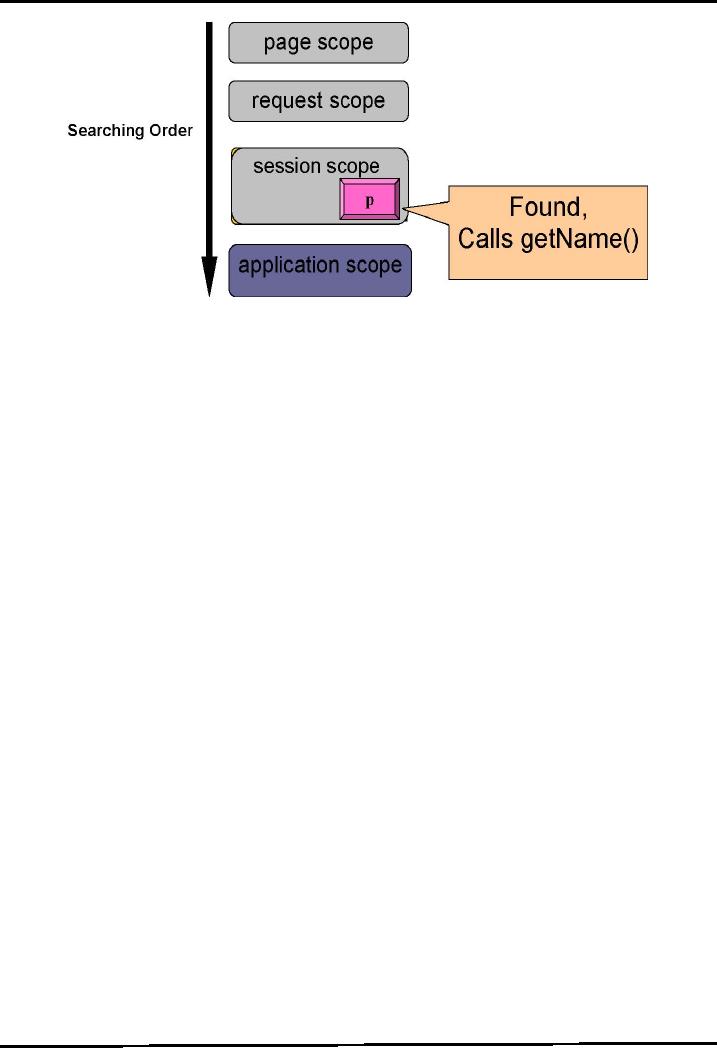 |
JAVA: Expression Language |
| << JAVA: Layers and Tiers |
| JAVA: JavaServer Pages Standard Tag Library (JSTL) >> |

Web
Design & Development CS506
VU
Lesson
42
Expression
Language
Sun
Microsystems introduced the Servlet
API, in the later half of
1997, positioning it as a
powerful
alternative
for CGI developers who were
looking around for an elegant
solution that was more
efficient and
portable
than CGI (Common Gateway
Interface) programming. However, it
soon became clear that
the
Servlet
API had its own drawbacks, with
developers finding the solution difficult
to implement, from the
perspective of
code maintainability and extensibility.
It is in some ways, this drawback
that prompted the
community
to explore a solution that
would allow embedding Java
Code in HTML Java Server
Pages
(JSP)
emerged as a result of this
exploration.
Java
as the scripting language in JSP scares
many people particularly web
page designers which
have
enough
knowledge to work with HTML and
some scripting language, faced lot of
difficulties in writing
some
simple lines of java code.
Can we simplify this problem
to ease the life of web
designer? Yes, by
using
Expression Language (EL).
JavaServer
Pages Standard Tag Library
(JSTL) 1.0 introduced the
concept of the EL but it was
constrained
to
only the JSTL tags. With
JSP 2.0 you can
use the EL with template
text.
Note:
-
JSTL will be discussed in the
following Handout.
Overview
The
Expression Language, not a programming or
scripting language, provides a way to
simplify
expressions
in JSP. It is a simple language that is
geared towards looking up objects, their
properties and
performing
simple operations on them. It is inspired
form both the ECMAScript and the
XPath expression
language.
JSP
Before and After
EL
To add in
motivational factor so that
you start learning EL with
renewed zeal and zest, a comparison
is
given
below that illustrates how
EL affects the JSPs.
The
following figure depicts the situation of
a JSP before EL. We have to declare a
variable before using
it,
data
type must be known in
advance and most importantly have to
use awkward syntax and many
more. All
these
problems are highlighted in the following
figure:
Contrary
to the above figure, have a look on the
subsequent figure that gives
you a hint how useful EL
can
be?
Person
Name: $ { p.name }
...
<c:if
test = "$ {p.address == param.add }"
>
Expression
Language Nuggets
We'll
discuss the following important
pieces of EL. These
are:
Syntax
of EL
331

Web
Design & Development CS506
VU
Expressions
& identifiers
Arithmetic,
logical & relational operators
Automatic
type conversion
Access
to beans, arrays, lists &
maps
Access
to set of implicit objects
EL
Syntax
The
format of writing any EL expression
is:
$ {
validExpression }
The
valid expressions can
consist on these individuals or
combination of these given
below:
Literals
Operators
Variables
(object references)
Implicit
call to function using
property name
EL
Literals
The
list of literals that can be
used as an EL expression and their
possible values are given in the
tabular
format
below:
Literals
Literal
Values
Boolean
true
or false
Integer
Similar
to Java e.g. 243,
-9642
Floating
Point
Similar
to Java e.g. 54.67,
1.83
Any
string delimited by single or
double quote e.g.
String
"hello"
, `hello'
Null
Null
Examples of
using EL literals are: . ${ false }
<%-- evaluates to false --%> . ${
8*3 } <%-- evaluates to 24
--%>
EL
Operators
The
lists of operators that can be
used in EL expression are given
below:
Type
Operator
Arithmetic
+ -* /
(div) % (mod)
Grouping
()
Logical
&&(and)
||( or) !(not)
Relational
==
(eq) != (ne) < (lt) >
(gt) <= (le) >=
(ge)
The
empty operator is a prefix
operation used to determine if
a
Empty
value
is null or empty. It returns a Boolean
value.
Conditional
?:
332

Web
Design & Development CS506
VU
Let
us look at some examples
that use operators as valid
expression:
${
(6*5) + 5 } <%-- evaluate to 35
--%>
${ (x >=
min) && (x <= max) }
${
empty name }
Returns
true if name is
Empty
string (""),
Null
etc.
EL
Identifiers
Identifiers
in the expression language represent the names of
objects stored in one of the JSP
scopes:
page,
request, session, or application.
These types of objects are referred to
scoped variables
throughout
this
handout.
EL
has 11 reserved identifiers,
corresponding to 11 implicit objects. All
other identifiers assumed to
refer
to
scoped variables.
EL
implicit Objects
The
Expression Language defines a set of
implicit objects given below in
tabular format:
Category
Implicit
Object
Operator
The
context for the JSP page,
used to access the
JSP
JSP
pageContext
implicit
objects such as request, response,
session,
out,
servletContext etc.
A Map
associating names & values of page
scoped
pageScope
attributes
A Map
associating names & values of
request
requestScope
scoped
attributes
Scopes
A Map
associating names & values of
session
sessionScope
scoped
attributes
A Map
associating names & values of
application
applicationScope
scoped
attributes
Maps
a request parameter name to a
single String
param
parameter
value.
Request
Parameters
Maps
a request parameter name to an
array of
paramValues
values
Maps
a request header name to a
single header
header
Request
value.
Headers
headerValues
Maps
a request header name to an
array of value.
A Map
storing the cookies accompanying
the
Cookies
cookie
request
by name
A Map
storing the context initialization
parameters
Initialization
initParam
Parameters
of the
web application by
name
Examples of
using implicit objects are:
333

Web
Design & Development CS506
VU
. ${
pageContext.response } -Evaluates to response implicit
object of JSP
. ${
param.name } -This expression is
equivalent to calling
request.getParameter("name");
${
cookie.name.value } -Returns the value of the
first cookie with the
given
.
name
-Equivalent
to if (cookie.getName().equals("name"){ String
val =
cookie.getValue();
}
Example
Code: Summation of Two Numbers
using EL
This
simple example demonstrates
you the capabilities of EL.
index.jsp is used to collect
input for two
numbers
and their sum is displayed on
result.jsp using EL. Let's
first see the code of
index.jsp
index.jsp
<html>
<body>
Enter two numbers to see
their sum
<form
action="result.jsp" >
First
Number : <input type="text"
name="num1" />
<br>
Second Number: <input
type="text" name="num2" />
<input
type="submit" value="Calculate Sum"
/>
</form>
</body>
</html>result.jsp
<html>
<body>
<%--
The code to sum two
numbers if we used
scriptlet
<%
String
no1 = request
.getParameter("num1");
String
no2 = request
.getParameter("num2");
int
num1 = Integer.parseInt(no1);
int
num2 = Integer.parseInt(no2);
%>
Result
is: <%= num1 + num2
%>
--%>
<%--
implicit Object param is
used to access
request
parameters
By Using EL summing two numbers
--
%> Result
is: ${param.num1
+ param.num2}
</body>
</html>
EL
Identifiers (cont.)
We had
started our discussion on EL
identifiers. Let's find out
how these identifiers
(variables) can be
stored/retrieved
in/from different
scopes.
Storing
Scoped Variables
By
using java code, either in
pure servlet or in a scriptlet of
JSP, we can store variables
in a particular
scope.
For example,
. Storing a
variable in session scope
using Java code
Assume
that we have PersonInfo class
and we want to store its
object pin session scope
then we can write
the
following lines of code to accomplish
that:
334

Web
Design & Development CS506
VU
HttpSession
ses = request.getSession(true); PersonInfo p =
new PersonInfo();
p.setName("ali");
ses.setAttribute("person" , p);
. Storing a
variable in request scope
using Java code
For
the following lines of code,
assume that request is of
HttpServletRequest type. To store
PersonInfo
object
p in request scope, we'll
write:
PersonInfo
p = new PersonInfo();
p.setName("ali");
request.setAttribute("person"
, p);
You
must be thinking of some another
method (with which you
are already familiar) to
store a variable in a
scope,
certainly by using JSP
action tags, we learned how to
store a variable in any
particular scope.
. Storing a
variable in request scope
using JSP action tag
If we
want to store p of type
PersonInfo in request scope by
using JSP action tags,
then we'll
write:
<jsp:useBean
id="p" class="PersonInfo"
scope="request"/>
Later,
you can change the
properties of object p by using
action tag as well. For
example
<jsp:setProperty
name="p" property="name" value="ali"
/>
Retrieving
Scoped Variables
You
are already very much
familiar of retrieving any
stored scoped variable by
using java code and
JSP
action
tags. Here, we'll discuss
how EL retrieves scoped variables. As
already mentioned, identifiers in
the
valid
expression represent the names of objects
stored in one of the JSP scopes:
page, request, session
and
application.
When
the expression language encounters an identifier, it
searches for a scoped
variable with that
name
first
in
page scope,
then
in request scope,
then
in session scope
and
finally in application
scope
Note: -
If no
such object is located in
four scopes, null is
returned.
For
example, if we've stored
PersonInfo object p in session
scope by mean of any
mechanism discussed
previously
and have written the following EL expression to
access the name property of p
${p.name}
Then
EL searches for p first in
page scope, then in request
scope, then in session scope
where it found p.
After
that it calls p.getName() method. This is
also shown in pictorial form
below:
335

Web
Design & Development CS506
VU
336

Web
Design & Development CS506
VU
$ {
"Hello" ${user.firstName}
${user.lastName} }
EL
also supports automatic type
conversion; as a result primitive
can implicitly wrap and
unwrap
into/from
their corresponding java
classes. For example
Most
importantly, if object/identifier is
null, no NullPointerException would be
thrown☺.
For
example.
If the expression written is:
${person.name}
Assume
that person is null, then no
exception would be thrown and the
result would also be
null.
Using
Expression Language
Expression
Language can be used in
following situations
As
attribute values in standard & custom
actions. E.g.
<jsp:setProperty
id = "person" value = ${....}
/>
In
template text the value of the
expression is inserted into the current
output. E.g.
<h3>
$ {
...... } </h3>
With
JSTL (discussed in the next
handout)
Example
Code: AddressBook using EL
So
far, we have shown you implementation of
AddressBook example in number of
different ways. This
time
EL will be incorporated in this
example. AddressBook code
example consists on
searchperson.jsp,
showperson.jsp,
ControllerServlet, PersonInfo and
PersonDAO classes. Let's
look on the code of each
of
these
components:
PersonInfo.java
The
JavaBean used to represent one person
record.
package
vu;
import
java.io.*;
public
class PersonInfo
implements
Serializable{
private
String name;
private
String address;
private
int phoneNum;
// no argument
constructor
public
PersonInfo() {
name
= "";
address
= "";
phoneNum
= 0;
}
//
setters
public
void setName(String
n){
name
= n;
}
public
void setAddress(String a){
address
= a;
}
public
void setPhoneNum(int
pNo){
phoneNum
= pNo;
}
337

Web
Design & Development CS506
VU
//
getters
public
String getName( ){
return
name;
}
public
String getAddress( ){
return
address;
}
public
int getPhoneNum( ){
return
phoneNum;
}
}
PersonDAO.java
It is
used to retrieve/search person records
from database.
package
vu; import java.util.*;
import
java.sql.*;
public class PersonDAO{
private
Connection con;
//
constructor
public
PersonDAO() throws ClassNotFoundException
, SQLException {
establishConnection();
}
//used
to establish connection with
database
private
void establishConnection()
throws
ClassNotFoundException
, SQLException
{
//
establishing connection
Class.forName("sun.jdbc.odbc.JdbcOdbcDriver");
String
conUrl = "jdbc:odbc:PersonDSN";
con =
DriverManager.getConnection(conUrl);
}
//
used to search person
records against name
public
ArrayList retrievePersonList(Strin g
pName)
throws
SQLException {
ArrayList
personList = new
ArrayList();
String
sql = " SELECT * FROM Person
WHERE name = ?";
PreparedStatement
pStmt = con.prepareStatement(sql);
pStmt.setString(
1, pName);
System.out.println("retrieve
person list");
ResultSet rs =
pStmt.executeQuery();
String
name;
String
add;
int
pNo;
while
( rs.next() ) {
338

Web
Design & Development CS506
VU
name
= rs.getString("name");
add =
rs.getString("address");
pNo =
rs.getInt("phoneNumber");
//
creating a PersonInfo
object
PersonInfo
personBean = new
PersonInfo();
personBean.setName(name);
personBean.setAddress(add);
personBean.setPhoneNum(pNo);
//
adding a bean to
arraylist
personList.add(personBean);
} //
end while
return
personList;
} //
end retrievePersonList
//overriding
finalize method to release
resources
public
void finalize( )
{
try{
if(con
!= null){
con.close();
}
}catch(SQLException
sex){
System.out.println(sex);
}
} //
end finalize
} //
end class
searchperson.jsp
This
JSP is used to gather person's name
from the user and submits
this data to the
ControllerServlet.
<html>
<body>
<center>
<h2>
Address Book </h2>
<h3>
Search Person</h3>
<FORM
name ="search" action="controllerservlet"
/>
<TABLE
BORDER="1" >
<TR>
<TD>
<h4 >Name</h4>
</TD>
<TD>
<input
type="text" name="name" /> </TD>
</TR>
<TR>
<TD COLSPAN="2"
ALIGN="CENTER"">
<input
type="submit" value="search" /> <input
type="reset"
value="clear"
/>
</TD>
</TR>
</TABLE>
</FORM>
</center>
</body>
</html>
ControllerServlet.java
The
Controller Servlet receives
request from searchperson.jsp
and after fetching search
results from
database,
forwards the request to
showperson.jsp.
package
controller;
339

Web
Design & Development CS506
VU
import
vu.*;
import
java.io.*;
import
java.net.*;
import
javax.servlet.*;
import
javax.servlet.http.*;
public
class ControllerServlet
extends
HttpServlet {
} //
end processRequest()
//
This method only calls
processRequest()
protected
void doGet(HttpServletRequest
request,
HttpServletResponse
response) throws
ServletException,
IOException
{
processRequest(request,
response);
}
//
This method only calls
processRequest()
protected
void doPost(HttpServletRequest
request,
HttpServletResponse
response) throws
ServletException,
IOException
{
processRequest(request,
response);
}
protected
void processRequest(HttpServletRequest
request,
HttpServletResponse
response) throws
ServletException,
IOException {
//
defined below
searchPerson(request,
response);
} //
end ControllerServlet
protected
void searchPerson(HttpServletRequest
request,
HttpServletResponse
response) throws
ServletException,
IOException {
try
{
//
creating PersonDAO
object
PersonDAO
pDAO = new
PersonDAO();
//
retrieving request parameter
"name" entered on showperson.jsp
String
pName =
request.getParameter("name");
//
calling DAO method to retrieve
personlist from database // against the
name entered
by the
user
ArrayList
personList =
pDAO.retrievePersonList(pName);
//
storing personlist in request
scope, later it is retrieved // back on
showperson.jsp
request.setAttribute("plist",
personList);
//
forwarding request to showperson, so it
renders personlist
340

Web
Design & Development CS506
VU
RequestDispatcher
rd = request.getRequestDispatcher("showperson.jsp");
rd.forward(request,
response);
}catch
(Exception ex) {
System.out.println("Exception
is" + ex);
}
} //
end searchPerson
showperson.jsp
This
page is used to display the
search results. To do so, it reclaims the
stored ArrayList (personList)
from
the
request scope. Furthermore,
this page also uses the
Expression Language to display
records.
<%--
importing required packages--%>
<%@page
import="java.util.*" %>
<%@page
import="vu.*" %>
<html>
<body>
<center>
<h2>
Address Book </h2>
<h3>
Following results meet your
search criteria</h3>
<TABLE
BORDER="1" >
<TR>
<TH>Name</TH>
<TH>Address</TH>
<TH>PhoneNum</TH>
</TR>
<%--
start of scriptlet
--%>
<%
//
retrieving ArrayList from
request scope
ArrayList
personList
=(ArrayList)request.getAttribute("plist");
PersonInfo
person = null;
for(int
i=0; i<personList.size(); i++)
{
person
= (PersonInfo)personList.get(i);
//
storing PersonInfo object in
request scope /* As mentioned, an
object must be
stored
in some scope to work with
Expression Language*/
request.setAttribute("p",
person);
%>
<%--
end of scriptlet
--%>
<TR>
<%--
accessing properties of stored
PersonInfo object with name
"p" using EL --%>
<TD>
${
p.name } </TD>
<TD> ${
p.address} </TD>
<TD>
${
p.phoneNum} </TD>
<%--
The following expressions
are now replaced by EL statements
written above--%>
<%--<%=
person.getName()%> --%>
<%--<%=
person.getAddress()%>
--%>
<%--<%=
341

Web
Design & Development CS506
VU
person.getPhoneNum()%>
--%>
</TR>
<%
} // end
for
%>
</TABLE
>
</center>
</body>
</html>
web.xml
<?xml
version="1.0"
encoding="UTF-8"?>
<web-app>
<servlet>
<servlet-name>
ControllerServlet </servlet-name>
<servlet-class>
controller.ControllerServlet
</servlet-class>
</servlet>
<servlet-mapping>
<servlet-name>
ControllerServlet
</servlet-name>
<url-pattern>
/controllerservlet
</url-pattern>
</servlet-mapping>
</web-app>
References:
.
Java A Lab Course by Umair
Javed.
. Expression
Language Tutorial by
Sun
http://java.sun.com/j2ee/1.4/docs/tutorial/doc/JSPIntro7.html
The
JSTL Expression Language by David M.
Geary
http://www.informit.com/articles/article.asp?p=30946&rl=1
342
Table of Contents:
- JAVA FEATURES
- Java Virtual Machine & Runtime Environment
- Learning Basics of JAVA
- JAVA: Object Oriented Programming
- JAVA: Inheritance
- JAVA: Collections
- JAVA: Intro to Exceptions
- JAVA: Streams
- JAVA: Modification of Address Book Code
- JAVA: Graphical User Interfaces
- JAVA: Event Handling
- JAVA: More Examples of Handling Events
- JAVA: Problem in Last Code Example
- Java Database Connectivity
- JAVA: More on JDBC
- JAVA: Result Set
- JAVA: Meta Data
- Java Graphics
- JAVA: How to Animate
- JAVA Applets
- JAVA: Socket Programming
- JAVA: Serialization
- JAVA: Multithreading 1
- JAVA: Multithreading 2
- JAVA Web Application Development
- Java Servlets
- JAVA: Creating a Simple Web Application in Tomcat
- JAVA: Servlets Lifecycle
- JAVA: More on Servlets
- JAVA: Dispatching Requests
- JAVA: Session Tracking 1
- JAVA: Session Tracking 2
- JAVA: AddressBook Case Study Using Sevlets
- Java Server Pages 1
- JavaServer Pages 2
- Java Server Pages 3
- JAVA: JSP Action Elements and Scope
- JAVA: JSP Custom Tags
- JAVA: MVC + Case Study
- JAVA: MVC Model 2 Architecture
- JAVA: Layers and Tiers
- JAVA: Expression Language
- JAVA: JavaServer Pages Standard Tag Library (JSTL)
- JAVA: Client Side Validation & JavaServer Faces (JSF)
- JAVA: JavaServer Faces